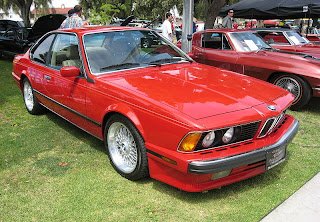
The BMW E24 series was the first BMW 6 Series coupé, produced by the German automaker BMW between the 1976 and 1989 model years. The 6 Series name reappeared with the BMW E63 chassis beginning in the 2004 model year. The E24 borrowed heavily from contemporary 5-series cars (E12, later E28). Model history
The E24 was a replacement for the CS and CSL coupés first produced in 1965. The CS 3.0 was almost changed by adding a few inches in height to make it easier for customers to get into the car. However, Bob Lutz rebelled against the decision and rough drafted an alternative version that soon became the 6 series[2]. Production started in March 1976 with two models: the 630CS and 633CSi. Originally the bodies were manufactured by Karmann, but production was later taken in-house to BMW.
In July 1978 a more powerful variant, the 635CSi, was introduced (for the time being not available in North America and Japan) that featured as standard a special close-ratio 5-speed gearbox and a black rear spoiler.
In 1979 the carburetted 630CS was replaced with the 628CSi; this car had a fuel injected 2.8L engine taken from the BMW 528i.
In 1982 (Europe) and 1983 (US), the E24 changed slightly, with an improved interior and slightly modified exterior. At the same time, the 635CSi received a new engine, a slightly smaller-bored and longer-stroked 3430 cc six to replace the former 3453 cc engine and became available with a wide-ratio 5-speed or an automatic.
E24s produced after June 1987 came with ellipsoid headlamps instead of the halogen lamps of earlier models. The sleeker European bumpers were also discontinued. Previous cars had either a European-standard bumper or a larger, reinforced bumper to meet the US standard requiring bumpers to withstand impact at 5 mph (8 km/h) without damage to safety-related components. 1989 was the last year for the E24 with production stopping in April. The E24 was supplanted by the considerably heavier, more complex, and more exclusive E31.
M Version
The M635CSi was introduced in Europe at the Frankfurt Motor Show in 1983. It is essentially an E24 powered by the powerplant of the BMW M1 (the M88, now putting out 286 PS (210 kW; 282 hp)). Most M635csi’s were equipped with special metric 415 mm diameter wheels requiring Michelin TRX tires. A catalyzed, lower compression ratio version of the car with the S38 engine putting out 260 PS (190 kW; 260 hp) was introduced in the U.S. in 1987. All M635/M6s came standard with a 25% rear slip differential. U.S. models included additional comforts such as Nappa leather power seats and a dedicated rear A/C unit with a center beverage chiller. Car and Driver tested a U.S. M6 in July 1987 and achieved a 0-60 time of 6.1 seconds, better than the BMW published 6.4 and 6.8 second times for the European and U.S. versions respectively. 4,088 M635CSis were built between 1983 and 1988 with 1,767 U.S. M6s built.[3]
In mid-model year 1978 the 630CSi was replaced by the 633CSi. US/Japan specification 633CSi cars had the M30 3.2 litre 181 hp (135 kW) engine until 1984. In 1985 the car was renamed 635CSi, displacement was increased to 3.4 litres and horsepower increased slightly to 182 hp (136 kW). The big difference, however, was torque. Whereas the 3.2 litre had 195 ft·lbf (264 N·m) at 4,000 rpm, the 3.4 litre powerplant managed 214 ft·lbf (290 N·m) at 4,000 rpm.
From model year 1983, North American and Japanese versions benefitted from the technical revisions and changes to the interior introduced elsewhere in spring or summer 1982. Its chassis was now based on the E28 and no longer on the E12. The front and rear suspension was also revised. Later a self-levelling rear suspension was added to the 635 CSi and M6 features list in 1988.
The US received its own M series E24 in 1987 called the M6. The S38 powerplant found in the US model had several modifications from the M88 powerplant in the European model, most notably: a double row timing chain, modified cam tray, different valve lengths, a slightly different cam profile, less elaborate exhaust manifold (rather than full headers), Bosch X5DC copper spark plugs (instead of Bosch Silver plugs on the M88) and the introduction of an oxygen sensor for the EFI. These changes coupled with the introduction of a catalytic converter for emission regulations reduced the output to 256 hp (191 kW). The US model also included a variety of options not found on the earlier European models, to include: heated power seats, sport tuned self-levelling rear suspension, A/C cooled ice box between the rear seats, A/C vents for rear seat occupants, sunshade for rear occupants and an 8 speaker “premium” sound system.
In 1988, the US E24 was now available with the newest version of the M30, the 3.4L (first used in the E32 735i). Even though the intake manifold states 3.5 it’s technically a 3.4 (3430cc) like the previous 3.4. This engine had an increased compression ratio, and updated Motronics/DME. The result was 208 hp (155 kW) and 225 ft·lbf (305 N·m) torque. In effect, this engine was identical to the catalyzed version newly available in Germany and other markets.




